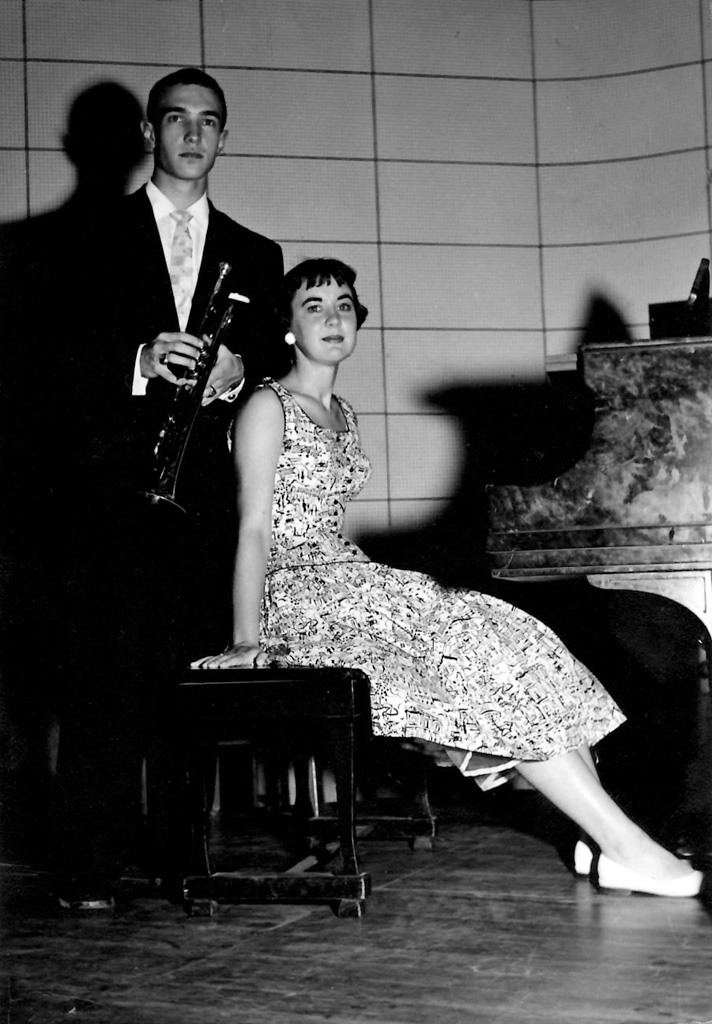
Notes
Below are a series of program notes for selected compositions by Fisher Tull. Feel free to use the note in its totality or edit it for space. Biographical information found elsewhere on this site can be included as well.
Eight Profiles (1980) — Fisher Tull (1934-1994)
The dedicatees of Eight Profiles were all members of a group of trumpet players who found themselves enrolled in college at the same time. Fisher Tull was one of this group who appeared in Denton, Texas to study music and the trumpet with John Haynie. Haynie continued to influence and shape trumpet players at that university until his retirement in 1990 and continues to “keep in touch” with many of his former students and younger players who seek his advice on the art of trumpet playing.
That Tull was a melodist cannot be questioned after just one listening to the Eight Profiles. That he played the trumpet is probably also apparent, perhaps more so to trumpet players. He also had a bent for musical form. Each Profile is a two-part exercise, if you will, akin to Bach’s Preludes and Fugues. The Profiles were composed as a set but the composer anticipated that only a few would be excerpted and performed in concert. Performing all eight is a Herculean task probably feasible only in recordings. Yet, hearing them side-by-side paints another portrait—one of the composer. Thematically he draws heavily upon his past works but recasts the music in a fresh way to showcase the trumpet and to honor his colleagues. But the overall effect is more than mere étude or sentimental reminiscing. What emerges is a beautiful portrait, or
Tull stopped playing the trumpet in the middle 1960s coinciding with his
Fisher Tull – Liturgical Symphony (1960) (published 1970)
From an article by the composer in The Instrumentalist;
“My first ‘serious’ works were Liturgical Symphony and Variations on an Advent Hymn, both for large brass-percussion ensemble and both based on sacred music. These two works represent a link between my arranging and the emergence of actual composition techniques. Liturgical Symphony uses six borrowed tunes with little development (almost a medley in fact) whereas Variations on an Advent Hymn consists of a theme with four extensive variation sections.”
These two works grew, out of necessity, from the fact that Tull was conducting the “brass choir” in his new position at Sam Houston State University. As he stated, these pieces represent a bridge between his extensive arranging activities at North Texas State (now University of North Texas) for the Lab Bands, among other commercial ventures, and his career as a composer of original music.
As stated, the Liturgical Symphony uses six borrowed melodies. With one exception (Edsall) the melodies all come from the Episcopal Hymnal. Tull began attending the Episcopal Church during his graduate school days and became a lifelong Episcopalian. He was very active in the Church and was a lay minister as well as serving on the Vestry of Saint Stephen’s in Huntsville.
The hymn tunes are as follows:
Movement 1:
Sanctus (from Missa Marialis) S115
Martyr Dei #209 (1940 Episcopal Hymnal)
Movement 2:
Picardy #324, from
Adoro devote #314
Movement 3:
Kyrie (from Missa Marialis) S92
Edsall chorale by George Henry Day
The music of the Episcopal (American Anglican) Church is a particularly rich source of thematic material, containing music from such noted composers as Gustav Holst, Ralph Vaughn-Williams, Healey Willan, and Thomas Tallis among many others. That Tull would have turned to the Hymnal as a source for thematic material seems hardly surprising given the circumstances described above. This material would also serve him very well in his most
Liturgical Symphony found its way to the publisher through a collaboration between Tull and Los Angeles studio trombonist, Dick Noel. Western International Music was run by William Schmidt, an acquaintance of Noel and thus, Tull. The piece was subsequently recorded by the Los Angeles Brass Society, conducted by Lester Remsen and made up of some of the finest brass players in the Los Angeles area.
Sonatina for Percussion
The Sonatina is written for four percussionists playing a total of 17 instruments, including the standard snare drum, cymbals, and triangle, as well as more unusual instruments such as antique cymbals and
The opening theme is presented in canonic style and developed through a series of cadenzas, one for each of the four players. The recapitulation actually continues developing the theme, subjecting it to numerous shifts in meter. Whereas the original theme is presented in simple meter, the “recapitulation” uses the theme in a compound meter. Keyboard percussion instruments add melodic motifs and the piece continues to grow in intensity until it reaches a rousing finale.
